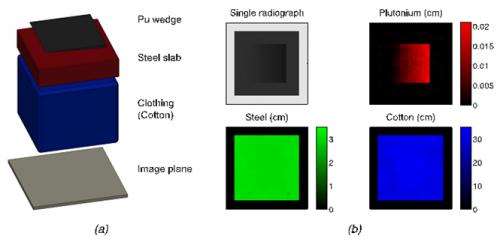Inverse modeling of X-ray imaging to combat nuclear materials trafficking

(Phys.org) —As part of the ongoing effort to curtail illicit trafficking of nuclear materials, scientists from Pacific Northwest National Laboratory and the University of Texas at Austin studied inverse modeling of spectral X-ray radiography to determine the presence of nuclear materials in small containers or composite objects, such as baggage. In their examination, the researchers applied an inversion algorithm to synthetic radiographs of objects composed of layers of plutonium, cotton, steel, lead, aluminum, and copper to estimate the quantities of these materials within the layers. Their work showed that coupling the algorithm with current-generation commercial detectors has the potential to distinguish small quantities of nuclear materials from other high-Z materials, such as nuclear material stowed within airline passenger luggage.
Extending existing imaging technology to detect small amounts of plutonium or highly enriched uranium hidden in composite objects could provide a major advance in combating the threat of nuclear materials trafficking.
Regularized inversion techniques, such as those Andy Gilbert (the paper's lead author) applied to this problem, have proven effective in distinguishing between multiple components of a given signal in a variety of applications. Using a list of possible materials and associated X-ray attenuation profiles as basis functions that are coupled to Beer's Law as a forward model to account for attenuation by photon absorption and scattering, the inversion breaks down the overall attenuated signal in each image pixel into components from the individual materials. These components are the coefficients in the forward model, representing areal densities of materials. Importantly, the algorithm has been developed to be adaptive, requiring minimal user input if deployed. Despite complicating factors associated with imaging high-density, high-Z objects, these techniques show promise for nuclear trafficking applications.
Building on the success of inverse modeling and using today's spectrally sensitive detectors to detect the presence of small amounts of plutonium in the simulated composite objects tested to date, the scientists are examining the model's potential to adapt and expand to high-energy X-ray systems and multiple X-ray spectra, as well as its application to verification of arms control treaty-limited items.
More information: Gilbert AJ, BS McDonald, SM Robinson, KD Jarman, TA White, and MR Deinert. 2014. "Non-invasive material discrimination using spectral x-ray radiography." Journal of Applied Physics 115(15):154901. DOI: 10.1063/1.4870043.
Journal information: Journal of Applied Physics
Provided by Pacific Northwest National Laboratory


















